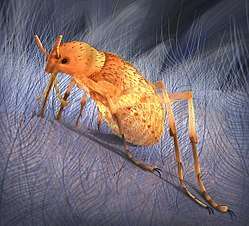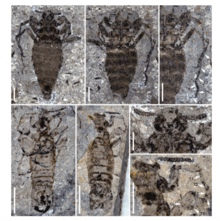Pseudopulex
Pseudopulex is a genus of extinct, flea-like, parasitic insects that once fed on dinosaurs or pterosaurs.[1] The latin root for the genera name Pseudopulex roughly translates to "false fleas".[2]
| Pseudopulex | |
|---|---|
 | |
| Restoration of P. jurassicus | |
| Scientific classification | |
| Kingdom: | |
| Phylum: | |
| Class: | |
| Order: | |
| Family: | Pseudopulicidae |
| Genus: | Pseudopulex Tai-ping Gao, Chung-kun Shih, Xing Xu, Shuo Wan, Dong Ren, 2012 |
| Species | |
| |
There are currently four identified species in this genus discovered through fossil remains: Pseudopulex jurassicus, Pseudopulex magnus, Pseudopulex wangi and Pseudopulex tanlan, with most current research focused on P. jurassicus and P. magnus.[3][4] While these parasites show similar characteristics to modern fleas, they also show major differences in body morphology and size due to the large difference in host, such as more flattened bodies and longer claws.[5] They also possessed serrated stylets, likely for feeding on blood through thick layers of skin. [6] Moreover, these organisms are likely to be about fifty times larger than the dog flea.[5] It is reported that the puncture of this parasite is compared to a hypodermic needle injection for these large dinosaurs.[5]
Discovery and phylogeny
Fossils of Pseudopulex jurassicus date back to the mid-Mesozoic of China, more specifically the middle Jurassic-aged Jiulongshan Formation, making them around 165 million years old, while Pseudopulex magnus were discovered to be from the Early Cretaceous Yixian Formation, around 125 million years ago.[4] Some possible hosts of P. jurassicus were Pedopenna daohugouensis and/or Epidexipteryx hui (feathered dinosaurs) and Sinosauropteryx prima or Microraptor gui may have been a good snack for P. magnus, simply because they were known to be present at the same time and place as these parasites.[7] These organisms are defined as having many similar features to other studied ectoparasites.[8] These organisms also share traits in common with present-day fleas, most obviously in their wingless bodies and stylets that are very long and sharp (used for piercing through flesh).[8] They also contain features that distinguish them from similar parasites, such as lice, because of their longer and more thin, clawed appendages as well as their extended mouthparts specific for bloodsucking.[8] There are traits that are completely different to modern fleas as well, which is said to be representative of this species possibly having an early evolution that resulted in a dead-end lineage.[9] There currently isn't much information regarding the evolution of fleas, but this genera is most similar to crown fleas.[4] Pseudopulex tanlan is considered to be somewhat of a transition organism between P. jurassicus or P. magnus and existing fleas as it has a smaller body plan, more compact antennae, and other features associated with fleas seen today.[3] Maybe their most critical difference from current fleas, such as crown fleas, is the lack of hind legs, prohibiting them from jumping or running, which is a common mode of transportation for most fleas today.[2] Presently, there has been a total of six other flea-like fossils that have been discovered along with this genus, which contributes to a better and more full understanding of the evolution of fleas.[4]

Morphology

The most common trait of these prehistoric fleas are their flat bodies, similar to common ectoparasites like ticks or bedbugs. [7] Even between the species of Pseudopulex, however, there are distinct differences in morphology, with P. jurassicus being slightly longer and containing a shorter stylet while P. magnus are thicker and have very long mouthparts. [8] P. tanlan was discovered to have an average sized body but smaller than other Pseudopulex species at about 10 mm long, with a relatively small head and thoracic cavity.[3] The body was also seen to contain setae that are very short and stiff. [3] Comparing to P. magnus and P. jurrasicus, this species has relative small male genitalia and short tibia on females.[3] P. jurassicus was a lot larger, with a length of 17 mm and mouthpart length of 3.4 mm, which is twice the size of its head.[7] This species had very small eyes, antennae, and a short torso with long, thick bristles covering the body.[8] Their legs were also quite long and contained a pair if large claws on the ends of each leg.[8] On the other hand, P. magnus was even larger, measured at 22.8mm long and 5.2mm long mouthparts.[7] Their head was relatively small and body compressed and stout (compared to P. jurassicus).[8] This species also contained antennae, dense setae, and claws on the ends of legs, but they also had a very uniquely large abdomen.[8] Line drawings were able to be created using fossils to provide a clearer understanding of morphology. [8] P. wangi females were about 14.8mm long with a small head with relatively short mouthparts, comparatively, and short antennae.[10] This species also contained larger eyes and body setae.[10] Males, however, were much smaller and had longer bodies, with genitalia being quite large, indicating P. wangi contains lots of sexual dimorphism within the species.[10]
Relevance
Understanding these prehistoric fleas, although they may be different in many aspects, contribute to the breakdown of things like Mesozoic biodiversity and ancient food chains, as well as gaining new information regarding current flea-like insect evolution.[2] Specifically, how these ectoparasites switched from only mammal hosts to also infecting bird species gives a snapshot of parasite evolution.[8] The Pseudopulex phylum displays the tremendous diversity present even millions of years ago, along with host-interactions that further aid in the study of ectoparasite evolution in today's world, giving novel insight into evolution, ecology, and host-parasite interactions that can be applied to modern-day ectoparasites.[4]
References
- "'Giant flea fed on dinosaur blood like mosquitoes' - NY Daily News". India.nydailynews.com. Archived from the original on 2012-05-04. Retrieved 2012-05-02.
- Leung, Tommy (2015-08-29). "Parasite of the Day: Pseudopulex jurassicus". Parasite of the Day. Retrieved 2020-03-02.
- Gao, Taiping; Shih, Chungkun; Rasnitsyn, Alexandr P.; Xu, Xing; Wang, Shuo; Ren, Dong (2014-08-27). "The first flea with fully distended abdomen from the Early Cretaceous of China". BMC Evolutionary Biology. 14 (1): 168. doi:10.1186/s12862-014-0168-1. ISSN 1471-2148. PMC 4154525. PMID 25158612.
- Gao, Taiping; Shih, Chungkun; Rasnitsyn, Alexandr P.; Xu, Xing; Wang, Shuo; Ren, Dong (2013-07-08). "New Transitional Fleas from China Highlighting Diversity of Early Cretaceous Ectoparasitic Insects". Current Biology. 23 (13): 1261–1266. doi:10.1016/j.cub.2013.05.040. ISSN 0960-9822. PMID 23810530.
- "Jurassic pain: Giant "flea-like" insects plagued dinosaurs". Life at OSU. 2012-05-01. Retrieved 2020-03-02.
- May 2012, Jeanna Bryner 02. "Dinosaur Fleas! Photos of Paleo Pests". livescience.com. Retrieved 2020-03-02.
- May 2012, Jeanna Bryner 02. "Monster 'Fleas' Put the Bite on Dinosaurs". livescience.com. Retrieved 2020-03-02.
- Gao, Tai-ping; Shih, Chung-kun; Xu, Xing; Wang, Shuo; Ren, Dong (2012-04-24). "Mid-Mesozoic Flea-like Ectoparasites of Feathered or Haired Vertebrates". Current Biology. 22 (8): 732–735. doi:10.1016/j.cub.2012.03.012. ISSN 0960-9822. PMID 22445298.
- "Siphonaptera - an overview | ScienceDirect Topics". www.sciencedirect.com. Retrieved 2020-03-02.
- Huang, DiYing; Engel, Michael S.; Cai, ChenYang; Nel, André (2013-05-01). "Mesozoic giant fleas from northeastern China (Siphonaptera): Taxonomy and implications for palaeodiversity". Chinese Science Bulletin. 58 (14): 1682–1690. Bibcode:2013ChSBu..58.1682H. doi:10.1007/s11434-013-5769-3. ISSN 1861-9541.
| Wikispecies has information related to Pseudopulex |
